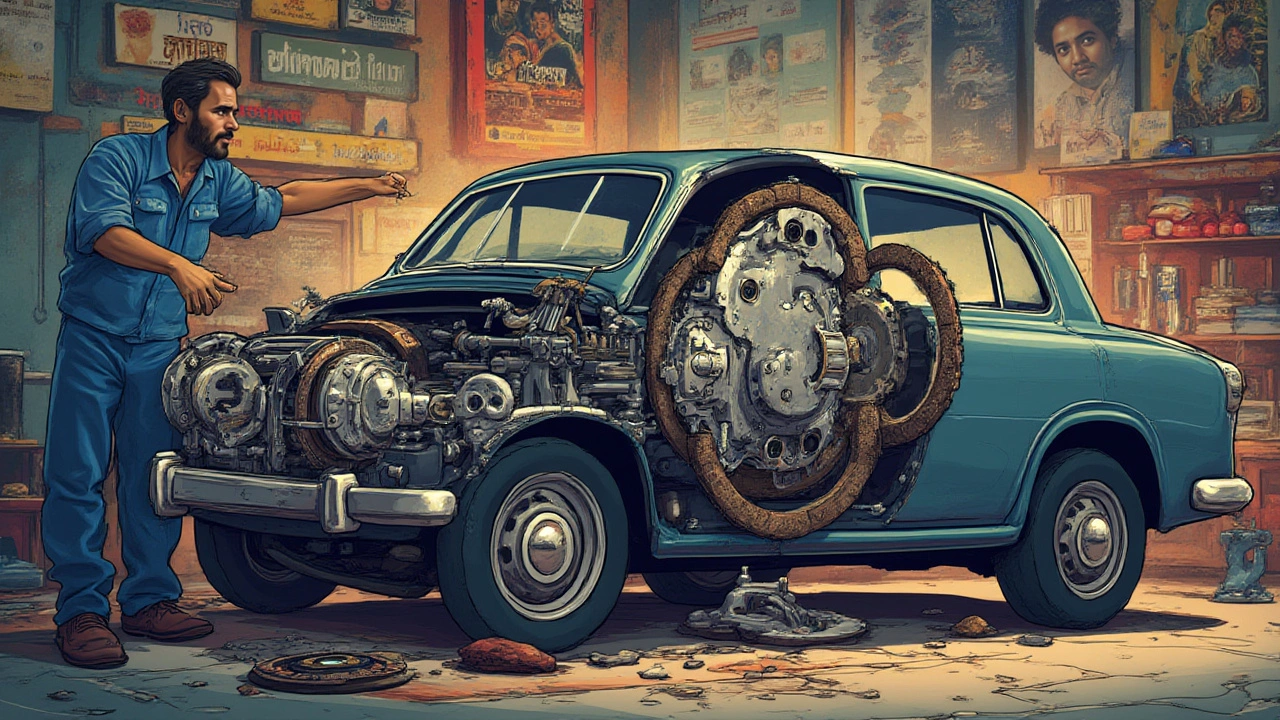 Jul, 18 2025
Jul, 18 2025
Picture this: you’re merging onto the highway, foot to the floor, but your car’s engine is revving like it means business—while the speedometer barely moves. That gut-dropping mismatch between revs and acceleration? Classic sign of a slipping clutch. This isn’t just frustrating; it could leave you stranded at the worst moment, and nobody wants to be stuck on the QEW when they should be rolling into work or off to cottage country. A slipping clutch’s symptoms can sneak up on you, slowly getting worse until you’ve got no choice but to deal with it. Understanding what a slipping clutch feels like can save you money, time, and a lot of driveway headaches.
How a Clutch is Supposed to Work
The clutch is the handshake between your engine and the transmission. Push down that pedal, and the clutch physically disconnects the two, letting you shift gears. Release the pedal, and the connection is made again—delivering all that power to your wheels. When your left leg is getting a workout shifting through city traffic, each gear change counts on that clutch working properly. The whole point is smooth, direct power transfer from your engine to the road. No drama, no fuss. In a healthy car, the process is nearly seamless. If you’re used to manuals, you barely think about it; your foot just knows. But, introduce some wear and age, and things don’t go so smoothly anymore.
You can blame a lot of forces for clutch wear—heat, friction, and even that habit of holding onto the clutch while stopped at lights. When materials in the clutch disc thin out or get glazed, grip gets compromised. Eventually, the clutch can’t squeeze tight enough. So the engine’s power, instead of being sent straight to the wheels, gets wasted as heat—while all those revs go nowhere fast. Some folks start noticing it when towing, hauling, or driving loaded. Others see problems pop up in city driving, where stop-and-go traffic speeds up the demise. Manual transmissions often last longer than automatics when properly cared for, but that clutch takes all the punishment.
Clutch lifespan varies, but here’s a stat: the average clutch usually covers anywhere between 80,000–160,000 kilometers depending on driving habits, quality of parts, and the environment. In Hamilton, where winters drop salt and cold across the roads, that lifespan sometimes dips. The grit and ice can make even careful drivers a little harsher on the clutch.
One thing’s for sure—clutches won’t last forever. And if you’re not paying attention, you’ll miss those early warning signs. But how do you know for sure your clutch is slipping? That’s where the “feel” comes in.
The Telltale Signs: What a Slipping Clutch Feels Like
When people talk about a clutch “slipping,” they’re really describing the exact moment when your engine speed and road speed get out of sync. What does that feel like behind the wheel? Right away, the big clue comes when you step on the gas in a higher gear—say you’re cruising at 60 km/h in third, and you jab the accelerator expecting a surge of motion. Instead, the engine roars, RPMs jump, but your speed barely rises, or rises much slower than you expect. It feels as if the car’s holding back, refusing to put that engine grunt to work. If you pay attention, you’ll spot other red flags:
- Strange Burnt Smell: Ever left your handbrake half on and noticed a sharp, acrid odor? A worn clutch often produces this unforgettable smell. It’s especially strong just after a demanding launch or hill start.
- Harder to Shift Gears: Sometimes, shifting gets rough, like the stick fights you every time you try to move it. That’s a sign the clutch isn’t disengaging or engaging the way it should.
- Spongy or Soft Clutch Pedal: That solid “bite” point disappears, replaced by a pedal that sinks to the floor too easily—or one that now grabs at a much higher point than you remember.
- Poor Acceleration: Even with the gas pedal mashed down, you’re left crawling along, especially under load. Hauling passengers or cargo makes it much more noticeable.
- Unexplained Increase in Engine RPM: Glance at your tach. If RPMs jump dramatically while your speed barely changes, you’re not imagining things.
A slipping clutch doesn’t always show all these signs at once. Sometimes it’s subtle enough you’ll convince yourself it’s “just in your head”—until it fails big time. Seasoned drivers get used to their clutch’s “bite point,” that moment when the clutch grabs. If it suddenly moves way up (almost right off the floor), take notice. Another neat trick: try driving uphill in a high gear and push hard on the gas. If either the RPM climbs but your speed doesn’t, or you smell something toasty, that’s your clutch giving you a handshake goodbye.

Why Clutches Slip and When to Worry
Why does a clutch start slipping anyway? There are a few suspects:
- Worn Clutch Disc: The surface material is like an eraser—it gets smaller every time you use it. When it’s down to the rivets, it can’t hold the engine and transmission together properly.
- Oil Contamination: If there’s an oil leak from the engine, crankshaft seal, or transmission input shaft seal, it can soak into the clutch disc. That makes it almost impossible to grip.
- Overheating: Repeated hard launches, towing beyond your car’s limits, riding the clutch, or heavy city driving in heat build excess temperature. That can glaze the friction material or warp the pressure plate.
- Faulty Pressure Plate or Broken Clutch Springs: These components keep the right amount of squeeze on the disc. When they fail, pressure drops, and slipping increases.
Nobody plans to wear out their clutch, but you can speed up the process without realizing it. A lot of drivers in Hamilton and Toronto are guilty of keeping the clutch half-engaged at lights or while crawling in bumper-to-bumper traffic. It seems like “clutch control,” but all you’re really doing is cooking the disc and flywheel. Even downshifting too aggressively or towing something your car wasn’t built for (looking at all the compact sedans towing utility trailers) invites trouble.
Is a slipping clutch dangerous? It sure can be. Lose clutch grip entirely and you’re not just stuck—you’re a sitting duck. City driving becomes a nightmare, and hills are a no-go. Even if you’re just ignoring slight slip for a while to save up for repairs, you’re risking a much higher bill. Every mile driven on a failing clutch means more wear on the flywheel, pressure plate, and hydraulic system. Wait too long and your clutch replacement turns into a multi-part transmission overhaul.
According to a 2023 survey from AAA Canada, over 20% of vehicles with manual transmissions fail regular clutch inspections—usually for excessive wear or improper installation leading to premature slipping. Mechanics report that one in five clutch replacements involve catastrophic wear because the owner waited too long after first symptoms appeared.
| Cause | Frequency (%) | Potential Repair Cost (CAD) |
|---|---|---|
| Worn Disc | 53% | $900–$1,600 |
| Oil Contamination | 18% | $1,200–$1,900 |
| Overheating/Glazing | 22% | $1,000–$1,600 |
| Faulty Pressure Plate | 7% | $1,200–$1,800 |
You can’t always predict when your clutch will give up, but you can prepare. Recognizing symptoms early gives you time to plan. The difference could mean escaping with a basic clutch kit rather than biting through your wallet for a new flywheel and seals.
What To Do If You Suspect a Slipping Clutch
So now you know what a slipping clutch feels like—what next? First things first, don’t panic. If you catch it early, you still have options. Stop driving aggressively and avoid towing or heavy loads until you get things checked. Here’s a step-by-step approach anyone can follow:
- Test for Slipping
- Find a safe, open area, shift into third or fourth gear at low speed, then floor the gas. If the engine revs climb but the car doesn’t surge forward, the clutch is slipping.
- Listen and sniff—burnt smell or odd noises are another clue.
- Check for Leaks
- Park on a dry surface and look for oil drops near the bell housing. If you spot fresh drips or stains, that’s a bad sign and could mean added repairs.
- Beware Quick Fixes
- Some products claim to "fix" a slipping clutch—these are gimmicks. They won’t restore friction, just mask symptoms for a while. If you plan on keeping your car, swap the clutch the right way.
- Get a Professional Diagnosis
- Most garages offer a clutch check for a reasonable cost. Mechanics inspect the pedal, test for free play, and if needed, take the transmission down to look at all the parts.
- Consider Upgrading
- If your car is used for towing, spirited driving, or races at Stoney Creek, talk to your mechanic about a heavy-duty or upgraded clutch kit. These can handle more abuse and might last longer if you ask a lot from your ride.
Here’s a tip: If you’re handy with tools, some clutch inspections are possible at home, but full replacement is rarely a DIY project unless you’ve got lots of experience. The transmission needs to come out, which means a lift (or at least a sturdy jack and stands), and a solid afternoon—or a lost weekend. Manuals for popular models like Civics, Golfs, or Mustangs have detailed procedures, but one missed step can turn a simple swap into a transmission nightmare. Play it safe if you’re not sure.
After new clutch install, break it in gently for the first few hundred kilometers. Avoid hard launches or towing during this time—think of it as “training wheels” for your new parts. Doing so will help it last far longer before you need to revisit the same problem.
If you’re stuck deciding whether to repair or sell, remember: a well maintained manual transmission with new clutch often adds real value—especially as stick shift cars become rarer. If you catch clutch slip early and fix it, you skip the heartbreak (and wallet ache) of a full replacement later on. And for anyone who loves the connection a manual brings, that’s worth the effort.